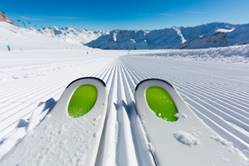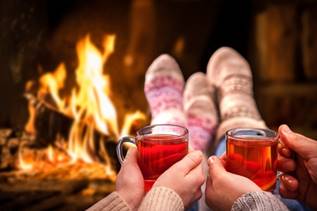Your Cart is Empty
Bust out your long johns and pack your Oxygen Plus O+ Elevate Pack because we're hitting the slopes! Here's a list of the best ski resorts in North America to get your juices flowing for ski season.
 Steamboat - Another Colorado favorite, Steamboat Ski Resort is the perfect option for the whole family, whether you're traveling with beginners, pros or a mix of the two. With nearly 3,000 acres and 165 runs, Steamboat is not known for its powder-perfect snow, but for its variation in easy, intermediate and difficult slopes.
Steamboat - Another Colorado favorite, Steamboat Ski Resort is the perfect option for the whole family, whether you're traveling with beginners, pros or a mix of the two. With nearly 3,000 acres and 165 runs, Steamboat is not known for its powder-perfect snow, but for its variation in easy, intermediate and difficult slopes.
Whether you're planning your first ride down the bunny hill or are prepping for the winter games, you don't want to forget to pack the most important skiing and snowboarding essentials. With the help of Oxygen Plus (O+), you'll be well on your way to your most memorable ski trip yet. Here's what to pack for your next winter adventure.

Don't forget to pack your O+ Elevate Pack – or the sleeker O+ Skinni or compact O+ Mini - featuring pure recreational oxygen to help you energize and combat the physical effects that occur at high altitudes. Those ski lifts take you pretty high, and O+ portable oxygen can help reduce the effects of altitude, including feeling tired and short of breath, while boosting your athletic performance at high altitudes. Oxygen Plus fits neatly in your ski pack for access pre- and post-descent.

 A long-sleeved or vest fleece layer
A long-sleeved or vest fleece layer
Altitude sickness is a temporary condition that can occur if you travel to altitudes around or above 8,000 feet. Those suffering from this condition may experience symptoms similar to a hangover, including headache, nausea, lethargy, dizziness, low appetite, insomnia, fever and fatigue (Altitude Sickness). If you're planning on hitting some of the highest peaks this season, you may experience some of these symptoms.
Because many North American ski resorts rise well above 8,000 feet, altitude sickness is a common occurrence on ski vacations, especially for travelers who normally reside at sea level. When your body adjusts to higher elevation, its experiencing a significant reduction in oxygen (Lomax).

WARNING: Oxygen Plus (O+) products are intended for recreational, intermittent use only and are not to be used as medical nor life-saving products. Any person with any type of health or medical condition should consult their physician prior to use of O+ products.
According to Altitude.org, there are three stages of altitude sickness. Mild altitude sickness is referred to as acute mountain sickness (AMS). This form is relatively manageable and easy to treat, but it should not be taken lightly. AMS may be a signal that your body is at risk of developing more serious forms of altitude sickness, which can be life threatening. The next two levels of altitude sickness can be extremely serious and fatal within hours.
High altitude pulmonary oedema (HAPE) is the next most serious form of altitude sickness, and it typically affects those who have spent two or three days at altitudes over 8,000 feet. Those with HAPE will experience extreme breathlessness, coughing and rapid heart rate. The most severe form of altitude sickness is called high altitude cerebral oedema (HACE), and should be treated immediately. HACE sufferers will experience severe headache, vomiting, lethargy, drowsiness and ultimately coma.
Although it's extremely important to be aware of altitude sickness risks while traveling at high elevations, if you're healthy, careful and aware of how you're feeling, you should be able to enjoy any ascent breathing easy. If you're a sea level dweller, ease into it the first couple days of your trip and slowly acclimatize at a moderate elevation. In addition to staying hydrated and oxygenated, professionals also recommend avoiding alcohol and hot tubs for the first few days of your trip.

In order to ensure skiers and snowboarders enjoy a safe descent that's appropriate for their own experience level, ski resorts often rate slope difficulty (or piste). In North America, Australia and New Zealand, a color-shaped rating system is common to indicate the difficulty of any particular incline. Trail difficulty is measured by percent slope, and a 100 percent slope is a 45-degree angle. The National Ski Area's Association (NSAA) has developed a typical convention for North American slope difficulty ratings is as follows, although this is just a rule of thumb:
Generally speaking, resorts will rate their trails by their most difficult part, regardless of whether or not the majority of the trail is relatively easy. Resorts will also take into consideration factors like the width of the trail, sharp turns, the roughness of the terrain and the level of maintenance performed on the trail throughout the season.
Because individual resorts and ski areas use their own ratings, there is no universal slope rating system. Although they may be similar from one resort to another, it's important to note that one resort's difficult may be another resort's intermediate (Ryan). A double black diamond may be used to indicate an exceptionally difficult slope.

Altitude.org | Altitude Sickness. N.p., n.d. Web. 11 Dec. 2016. Lomax, Becky. "How to Avoid OnTheSnow. N.p., n.d. Web. 11 Dec. 2016.
Ryan, Michael. "Ski Slope Symbols: Black Diamond, Green Circle, Orange Oval, and More." Outdoor Tech Blog. N.p., 2016. Web. 11 Dec. 2016.
